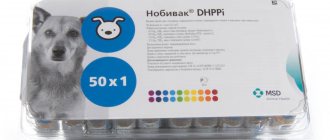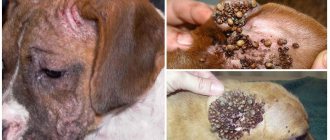Pyoderma in dogs or purulent skin lesions
Purulent skin lesions in dogs, or pyoderma, are ubiquitous. Animals of all breeds are susceptible. However, the following dog breeds are most prone to pyoderma: Shar Pei, Mastino Neapolitan, Bullmastiff, Chow Chow Boxer, Pug, Chihuahua, English Bulldog, French Bulldog. Pyoderma in dogs is a skin disease in the form of an accumulation of pus. In the superficial form, the outer layers and hair follicles are affected. The deep form of pyoderma is characterized by damage to the skin throughout its entire thickness. Sometimes the subcutaneous tissue and muscles are affected.
Symptoms of skin disease
Skin diseases of dogs, unlike internal ones, are most often transmitted to humans. There are three types of symptoms indicating that the disease is skin:
- Severe itching.
- The appearance of peeling and redness around the tumors.
- The presence of pus and severe inflammation.
If all three signs are present, you should quickly treat your pet and go to the hospital yourself for examination.
Pyoderma in dogs - causes and development
Pyoderma is caused by several reasons. The main reason is a decrease in immunity. A decrease in the body's defenses occurs as a result of a change in living conditions, feeding or movement. For example, a dog has been constantly kept indoors (apartment or house) and is sent to live outside. Or a dog that constantly lived in the courtyard of a private house is taken to live in an apartment. Changing feeding affects the immune system not only when reducing calories. The dog gets its main source of antibodies, protein, from meat. To save money, meat is often replaced with offal and entrails. Such a replacement, even while maintaining the energy value of the food, reduces the nutritional value and cannot meet the dog’s needs. You should adhere to the recommended ratio of meat, offal and slaughterhouse waste, and cereals for the breed.
Switching adult dogs to dry or canned food exacerbates a number of chronic diseases that reduce immunity. After about one and a half to two months, these processes return to normal. Immunity is fully restored 4 months after switching to dry food.
It is necessary to take into account the relationship between movement and feeding. So, during training, a dog requires about 15 - 20% more food. During intensive work, the needs increase up to 40%.
Lack of exercise is just as harmful for dogs as too much. If there is a lack of movement, the skin does not cleanse itself. Dust, dead pieces of skin, and various secretions accumulate in the wool, serving as food for microbes.
A secondary cause of pyoderma is considered to be a violation of the integrity of the skin. So, running through the meadows in the fall, puppies often injure the skin of their abdomen on dry grass. The short hair of Bulldogs, Bullmastiffs and Shar-Peis scratches the skin in the folds.
Worms, fleas and microscopic mites contribute to the development of pyoderma. The presence of parasites reduces immunity. In addition, fleas and microscopic mites damage the skin. The skin in folds on the face (in bulldogs and similar breeds), near the genitals and on the abdomen (in large breed puppies) is especially susceptible to pyoderma.
Other pathologies
Eczema
Owners rarely notice eczema at an early stage, since all the changes that occur are masked by the fur. The symptoms of this inflammatory disease depend on its form:
getting wet
. Accompanied by severe pain, chills and fever. Numerous ulcers periodically break out, moisturizing the skin with their contents. Dried exudate sticks the fur together, giving it an unkempt appearance. Due to ulceration, the lesion rapidly increases in size.
Dry
. The epidermis covers the rash or papules. They itch but are not painful. Due to scratching, the skin becomes very flaky, becoming covered with dandruff and seborrheic plaques. The fur slowly thins and then begins to fall out in clumps.
The disease is not transmitted to humans or other domestic animals. First of all, it is dangerous for the patient, since the wounds on his body are very attractive to pathogenic microorganisms.
Atopic dermatitis
Atopy is a type of allergy that occurs due to genetic predisposition. Most often it appears at the age of 1-5 years and is accompanied by:
baldness of certain areas of the body;
thickening of the skin and disruption of its pigmentation;
numerous suppurations at the site of scratching.
In rare cases, atopic dermatitis leads to otitis media and lameness. This disease is characterized by a series of remissions and exacerbations. Depending on the severity of the course, attacks can occur every six months, every month or on an ongoing basis.
Seborrhea
Most often, seborrhea affects the line along the spinal column, paws and abdomen. The secretion that accumulates there gives the fur an untidy appearance and an unpleasant odor.
Depending on the cause of the problem, dandruff can be dry or oily. In the first case, incorrectly selected shampoos and too frequent washing are to blame, removing the protective layer from the skin. In the second case, the problem lies in the too intense work of the sebaceous glands.
numerous scales, dry crusts and small rash – cheyletiella yasguri mite;
Owners of puppies often come to me with complaints of difficulty and frequent urination in drops, which may contain an admixture of mucus, pus and blood. Sometimes there is irritation around the loop in female puppies; in male puppies, such irritation with the release of purulent drops occurs on the prepuce. I would call all this one comprehensive diagnosis “vaginitis of female puppies” or “urethritis of male puppies”.
If you take a urine test, it will show in almost 80% of cases the presence of concentrated urine and crystals. This can go away with age on its own, or it can develop into chronic diseases of the bladder and urethra. It is also possible to develop chronic vaginitis and urethritis, which can subsequently be complicated by disease of the uterus in females and genitals in males.
Symptoms: the puppy often sits down for a “small” need, sits for a long time, while the amount of urine can be scanty with an admixture of mucus, pus and drops of blood. Sometimes this process can be quite painful, then the puppy whines pitifully every time he tries to urinate. Irritation of the urethra and loop area with concentrated urine can cause itching and burning. The puppy is constantly busy with the hygiene of the loop or prepuce and the skin around them. The skin near these places can be irritated, swollen, hyperemic, hot to the touch, and even pustular rashes are not uncommon. Typically, many veterinarians diagnose such symptoms as cystitis and prescribe antibiotics and sulfonamides. But considering that the root cause is still the formation of tripelphosphates (urine crystals), then just prescribing antibiotics or sulfonamides alone is not enough, and sometimes it is simply inappropriate, since inflammation is not the root cause, but a consequence. And many of my colleagues, unfortunately, miss this cause-and-effect relationship.
The reason lies in the fact that puppies' urine is much more concentrated than that of an adult dog, and therefore the formation of heavy crystals is inevitable. Urine for analysis for the presence of crystals must be taken after a fairly long period of abstinence, preferably the first portion in the morning. Then the indicators will be most reliable.
Causes of cystitis in puppies: small puppies consume little fluid, despite the fact that puppies’ diet is always rich in mineral salts. This leads to the formation of a precipitate of these salts in the bladder, which crystallizes. These crystals settle at the bottom of the bladder, irritating the walls of the bladder, changing the pH of the urine (acidity). Inflammation from the walls of the bladder passes downwards to the mucous membranes of the urethra, it also becomes inflamed, its walls thicken and are quite painful. Due to the narrowing of the lumen of the urethra, urine cannot flow out completely when the bladder sphincter is open but inflamed. It stagnates in the bubble, which makes it even more concentrated. Inflammation of the mucous membranes of the urinary tract promotes the proliferation of bacterial flora, which leads to further precipitation in the urine. And this process can be endless. This is the relationship of cause and effect.
Treatment: as I wrote earlier, just prescribing antibiotics and antibacterial sulfonamides is not enough. These drugs only affect the effect, without eliminating the cause. The cause is eliminated as follows: a diet that helps dissolve the crystals and change the pH of the urine. This could be a fermented milk diet, some vegetable juices: cabbage or tomato, you can also add a small amount of fresh cranberry juice to your drinking water. WATER. Having free access to water at any time is mandatory. It is the lack of fluid intake into the body, and therefore the insufficient production of urine, that causes the urine to become more concentrated, and crystals are more likely to form in it. In a word, the puppy must wash itself. Drinks - urinates, drinks again - urinates again. And don’t be afraid of the large number of puddles. We should be happy about this. This is especially true for puppies, who are already beginning to be accustomed to cleanliness in the house, forcing him to endure need until the next walk. There is no need to be lazy, you just need to take the puppy outside often to relieve itself. Let it be 5, let 10, let 15 times. But don't force your puppy to endure it. The second rule: careful hygiene of the puppy’s external genitalia. In bitches, daily hygiene of the skin around the loop. In male dogs, the hygiene of the prepuce and preputial sac is important. Puppies are too young to take care of themselves. And the owners’ task is to help them with this. As a rule, the ability to care for a child comes with the onset of puberty.
We recommend reading: Who Bred Hairless Cats
In conclusion, I would like to add that puppy cystitis is more often observed in female puppies than in male puppies.
Pyoderma in dogs - symptoms
Microbes that normally live in the dog’s body instantly rush to the site of damage. When paws are damaged, fungi from the soil also enter the wound. 3 - 5 days after entering the wound, microorganisms begin to multiply rapidly and acquire pathogenic properties, the skin becomes inflamed. Severe itching occurs. By combing the affected areas, the dog rubs microorganisms into the hair follicles. Claws scratch the skin, and microbes settle in the scratches.
Without qualified help, the ulcers unite into large cavities, slowly poisoning the dog with the contents. Severe itching occurs. By combing the affected areas, the dog rubs microorganisms into the hair follicles.
A few days after severe itching appears, red and yellowish blisters are visible on the skin. When pierced, they release liquid with an unpleasant odor. Over time, the dog's hair falls out. The affected areas become bald, and the blisters merge into shapeless areas. When animals scratch, the blisters can burst, spreading an unpleasant odor and germs. This is how the superficial form of pyoderma manifests itself.
After a few days, the pus eats away at the layers of skin underneath the hair follicles. Along with the flow of pus, microbes settle in the lower layers of the skin.
The body of a sick dog tries to respond to the development of microbes. The production of antibodies increases, macrophages are sent to the sites of microbial development. But the dog’s body cannot cope with the infection in the skin. Microbes spread throughout the body and can cause inflammation in various organs. Over time, the pustules merge into large boils that can open at any point on the dog’s skin. Purulent fistulas appear, up to 7 cm deep in large dogs. This is how the deep form of pyoderma manifests itself.
The disease can last for years; Without qualified help, the abscesses unite into large cavities, slowly poisoning the dog with their contents.
Pyoderma in dogs - treatment
It is carried out only in a veterinary clinic. Symptoms similar to pyoderma appear in completely different diseases. For example, distemper, ingestion of extraintestinal heartworms. Purulent skin lesions are complicated by attacks by microscopic mites, such as demodicosis.
source
Types of skin diseases
Blisters are sometimes caused by a number of skin conditions. The following is a list of skin diseases that Xoloitzcuintles are most susceptible to.
- Dermatophytosis is a fungal infection of the skin that occurs due to weakened immunity. When infected, the animal develops bald patches and, in rare cases, growths.
- Pityrosporosis is a disease caused by a fungus. The dog's skin develops: redness, bald patches, blisters. The main symptom is mucous discharge on damaged areas.
- Atopic dermatitis is a type of allergy. The exact cause of atopic dermatitis is unknown. Symptoms are the appearance of neoplasms.
Blisters in dogs
The occurrence of blisters in dogs, as a rule, greatly worries their owners. The problem mainly lies in the fact that they do not know what could have caused these formations and are trying to cure them with ordinary ointments or folk remedies. In fact, there can be many reasons for the occurrence of blisters - from simple allergies to viral infections. Moreover, few owners are aware that blisters are classified not only by color and content, but also by their location on the animal’s body.
Blisters in dogs can occur on the skin, genitals, and also in the mouth. They are usually caused by different reasons and, of course, they require different approaches to treatment.
What symptoms should you pay attention to?
Despite the possibility of the formation of different foci of damage to the reproductive organs of the animal, in most cases, inflammatory processes and associated discharge from the loop have common symptoms. The main signs of trouble in this case include:
- the dog’s increased attention to its genitals, which is often accompanied by licking the area under the tail;
- lethargic and apathetic state;
- increased body temperature;
- increase in abdominal volume;
- increased thirst, causing the dog to drink a lot of water;
- shortness of breath, which appears not only when climbing stairs, but also during normal walking;
- vomiting or urge to vomit;
- refusal to go for a walk;
- frequent urination, sometimes even at home, in small portions.
Most of these signs appear only in advanced stages of the inflammatory process, while in the initial stages of the disease, owners do not always pay attention to changes in the behavior of their pet. The earlier the diagnosis is made, the greater the chances of a positive treatment outcome.
Blisters in the mouth of dogs
Possible causes of blisters:
1. A viral infection enters the animal’s body.
2. Allergies to medications, food, chemicals.
3. Burns caused by consuming too hot food or dishes with the addition of spices or herbs, electrical burns.
4. Dental problems.
Symptoms. Some of the above reasons for the occurrence of blisters in dogs can cause the animal to become slightly lethargic and lethargic, as well as an increase in temperature. If your pet's temperature rises above 39 degrees Celsius, the blisters are most likely caused by a viral infection. If the dog looks weak and sick for at least a couple of hours, you should immediately take the animal to a veterinary clinic.
If, on the contrary, the pet, despite the blisters, looks absolutely healthy, does not experience itching, and the blisters themselves do not look inflamed, there is a possibility that they will disappear on their own, without any external intervention. However, if 1.5 weeks have already passed and the symptom still does not go away, you need to consult a doctor. Before visiting a specialist, try to remember whether your pet has eaten spicy dishes from the family table and whether he has had contact with unknown plants or household chemicals.
If you suddenly notice that your dog has just come into contact with a dangerous chemical or poisonous plant, you should immediately rinse your pet's mouth with cool water or apply a cold ice pack, and then consult a doctor.











